


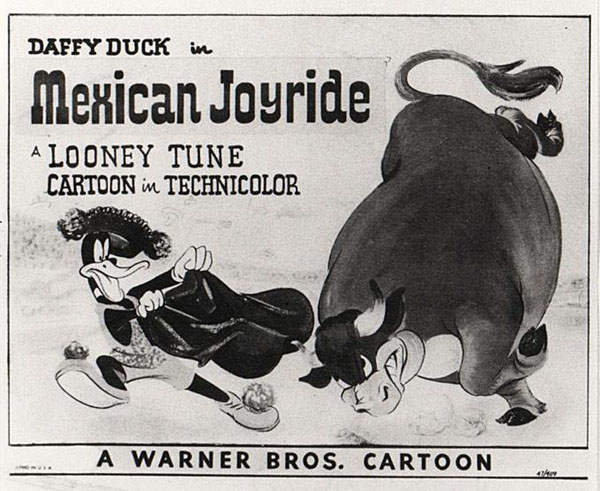
A new one already?! Yes, a mere three months after the second volume, we have Looney Tunes Collector’s Choice Vol. 3, and it’s another winner for the Warner Archive Collection.
So not to repeat myself, readers can look at my reviews of Vol. 1 and Vol. 2 for more details about this series, and why it’s important. To sum it up, it’s more of the same: twenty-five new to Blu-Ray cartoons, with two newly remastered (both Art Davis Daffy classics Mexican Joyride and Riff Raffy Daffy) mixed with pre-existing Max/MeTV masters (Adobe Suite/“Photoshop” titles and all).
 On the one hand, the haste to get these out the door results in some rather blatant errors making it to press (the opening WB shield on There Auto Be a Law artificially “circles” in rather than zooms; Egghead Rides Again has some opening animation artificially re-looped) when a little more time could have fixed them.
On the one hand, the haste to get these out the door results in some rather blatant errors making it to press (the opening WB shield on There Auto Be a Law artificially “circles” in rather than zooms; Egghead Rides Again has some opening animation artificially re-looped) when a little more time could have fixed them.
On the plus side, with three discs now under WAC’s belt, collectors have been able to add more than a Golden Collection’s worth of Warner cartoons with a marginal number of defects to their high-definition libraries in less than a year’s time. Everything, generally, looks perfectly fine and many are quite revelatory in detail. After years of inactivity, that’s certainly worth celebrating.
Fellow nitpickers will appreciate, however, that they did fix a few sloppy things in the titles of the Max masters (like a bad paste-job in Cinderella Meets Fella and an artificial fade out in Punch Trunk) and seem to have actually gone back to the original scans to use the opening titles as filmed on many cartoons. A pretty quick, inexpensive fix, and I urge Warner Archive to do this for every cartoon.
Vol. 3 is an improvement over Vol. 2 with a better classic to dud ratio that gives a great cross-selection of the Warner filmography, ranging from the very first cartoon they did in color to some of the very last they ever made. The jury’s still out if we’ll see the black-and-white cartoons from the first half of the ‘30s or the “post-64” second half of the ‘60s (though I’m sure very few are lamenting the lack of latter). This volume also dips its toe into real “collector territory”, highlighting a few notorious titles with racial caricatures I was actually surprised to see turn up. Let’s hope this bodes well for more complete future releases.
The playlist…
A Feud There Was (1938, Tex Avery)
Self-aware, fourth-wall breaking hillbilly fun, with a bulbous-nosed, invasive peacemaker identified onscreen as “Elmer Fudd”. I’ve had a longstanding “feud” myself with a few fellow cartoon historian pals about Egghead and Elmer coexisting as separate characters because merchandising and publicity identified them as such. Egghead = Moe Howard haircut, Elmer = bald. Their reasoning is the likes of Tex, Bob Clampett, and Chuck Jones all misremembered and conflated the two characters as one. As this drawing done by animator Virgil Ross at the time shows, however, the designs and names were always interchangeable. The real answer: studio flacks were just trying to make sense out of something the creators didn’t care about.

A Hop, Skip and a Chump (1942, Friz Freleng)
Grasshopper Hopalong Casserole tangles with a pair of crows that “resemble” Laurel and Hardy. Extremely underrated, as “The Boys” hadn’t been caricatured so perfectly since Art Babbitt’s animation of them in Mickey’s Polo Team (Mel Blanc’s voice, though not all there, adds to it, too). Perhaps L&H’s Fox movies at the time would have benefited from Freleng and Mike Maltese’s involvement. And a vast improvement over the earlier prints and transfers, which always looked just brown. (The grasshopper apparently survived as he was seen again as Bugs Bunny’s heckler rival in the first Bugs One Shot comic book that year.)
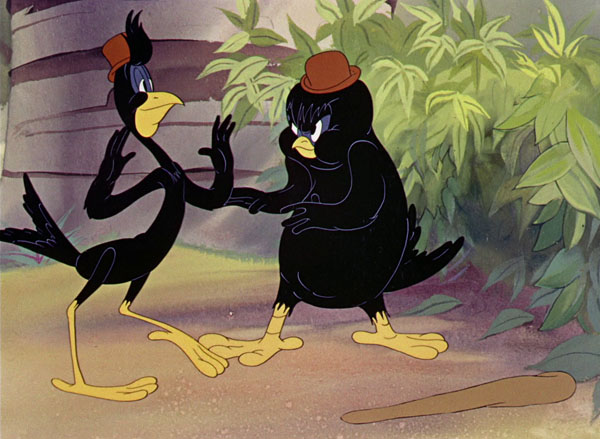
China Jones (1959, Robert McKimson)
One of the many, many TV parodies from McKimson, this time of China Smith, a show that lasted one year in the 1952 broadcast season, starring Daffy as the lead and Porky Pig as a derogatory “Charlie Chung” caricature. (Bob Jaques and I surmised writer Ted Pierce likely rolled out of bed hungover and pitched whatever he saw on TV the night before to McKimson.) Long suppressed for its broad Asian depictions and an infamous “prisoner in a Chinese laundry” ending.

Cinderella Meets Fella (1938, Avery)
Avery’s second fairytale parody, with Egghead/Elmer as the goony Prince Charming. The extent of the fourth-wall breaking must’ve been something to see at the time of its release.

Dumb Patrol (1964, Gerry Chiniquy)
Freleng unit veteran Gerry Chiniquy directs a short with Friz’s unit after he left the studio, and it’s too bad it fell so flat. Fearless Leader Jerry Beck considers this WWI battle between Bugs and Sam (and a two scene, silent appearance by Porky Pig) one of the very worst Warner cartoons, but I could easily see this done a decade earlier in the Bunker Hill Bunny vein and be a classic. Instead, it plays like a handful of other Freleng unit shorts done at the end of the original run that are barely a step up from limited animation and feel like proof-of-concept pilots for DePatie-Freleng cartoons that are actually worse than anything that studio would do that decade.
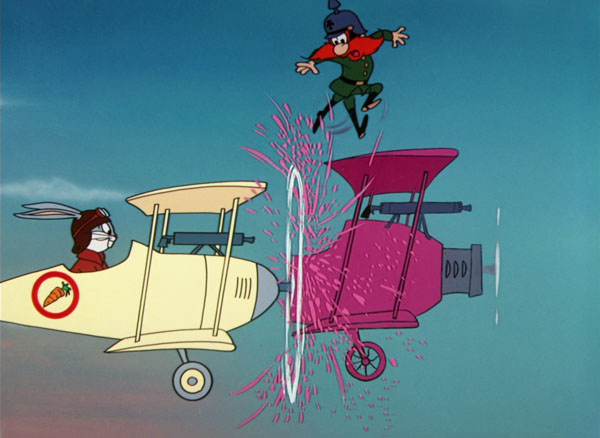
Egghead Rides Again (1937, Avery)
The debut of the little twerp, who literally mails himself to the dude ranch where he hopes to get a job. Irv Spence animation galore, and one of the most impressive looking restoration jobs.
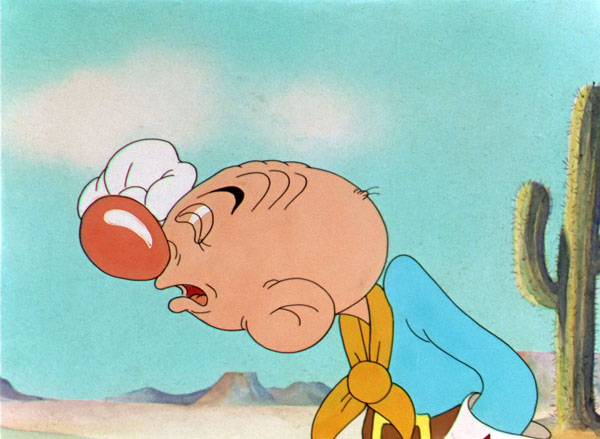
Elmer’s Pet Rabbit (1941, Chuck Jones)
Jones’ first cartoon with the newly redesigned Bugs Bunny, and the first time he’s identified by name onscreen. All of the odd “creative” choices—it’s one of two cartoons where he wears yellow gloves, which they quickly realized was a design faux pas (but wasn’t enough to dissuade the makers of the recent Looney Tunes Cartoons reprisal), and also the only time he speaks with a Jimmy Stewart-ish voice—tend to overshadow that the cartoon shows Jones always saw Bugs as a world-weary sophisticate (the endless dialogue calls to mind later Jones gabfests like Knight-Mare Hare).

Hobo Bobo (1947, McKimson)
An almost Disney-like cartoon in execution (you can almost just imagine Sterling Holloway narrating this rather than Bob Bruce) with Bobo the Elephant exploiting alcoholism and paranoia to reach opportunity in America. Long seen in its Blue Ribbon reissue, the original titles have been restored for this release.
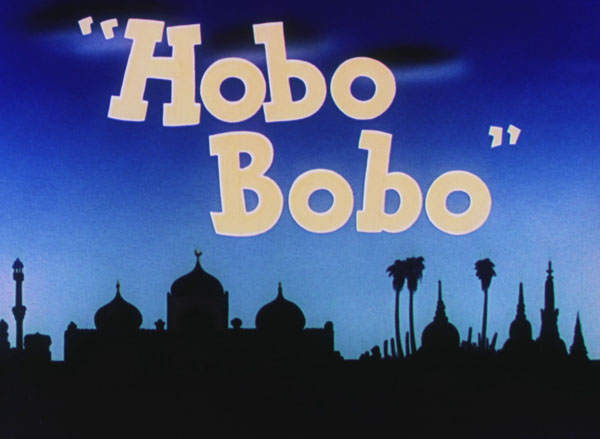
Note that this is a titles reconstruction that uses the opening rings and production number from Hollywood Daffy. I had seen the vault print utilized and it was in very rough and incomplete shape, so considering the alternative is NOT seeing the original credits/music at all… this is a non-issue.

Honeymoon Hotel (1934, Earl Duvall)
The first Warner cartoon in color, with insects performing the song heard in Footlight Parade (1933), and it’s just as pre-code bawdy. A glimpse at “what coulda been”, as all of the cartoons Earl Duvall directed are really good. If it weren’t for an alcohol-fueled argument between Duvall and Leon Schlesinger, Warner cartoons might have had a more interesting interim between Harman and Ising’s departure and Avery’s arrival.

I Only Have Eyes For You (1937, Avery)
Early Avery “boy doesn’t get girl” picture that includes a Man of a Thousand Voices and a horny old maid.

Mexican Joyride (1947, Art Davis)
Director Davis hits it out of the park with his first Daffy cartoon, proving he was a natural fit for the character (as he did with his animation for Tashlin and Freleng). The savagery of bullfighting hits its peak when bullfighter Daffy supplies a machine gun meant for the bull’s own suicide. “Caramba!” The one newly and fully restored cartoon on the disc looks stunning.
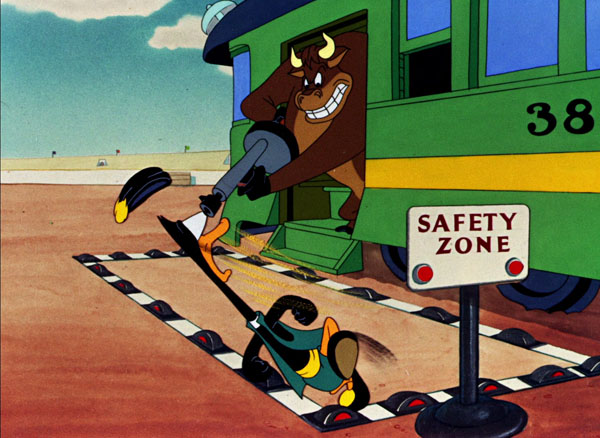
The Mouse on 57th Street (1961, Jones)
Mike Maltese’s last credit for Warners is a bit of a throwback to the kinds of one-shots he and Jones did in the ‘40s. A mouse with a hangover pilfers a diamond to keep his head cool and is pursued by a “Lennie and George” team of cops. (If the cartoon wasn’t actually made years before Car 54, Where Are You?, you’d swear it was a sendup.)
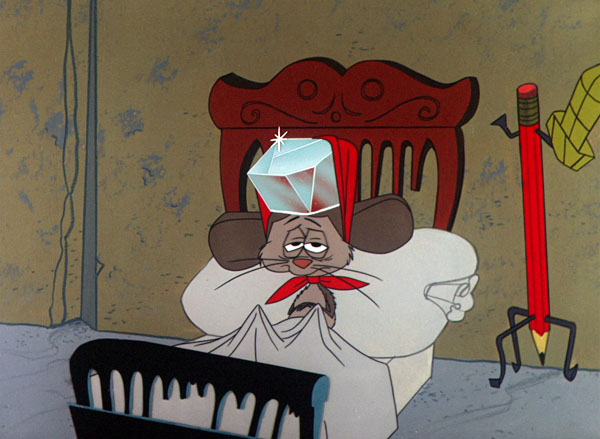
Mr. and Mrs. Is the Name (1935, Freleng)
Early color Merry Melody with topless mermaids (they got away with this by not depicting nipples). The Internet likes to say it’s black-and-white Looney Tunes “stars” Buddy and Cookie’s only color appearance, but more than likely they just got economical with character designs.
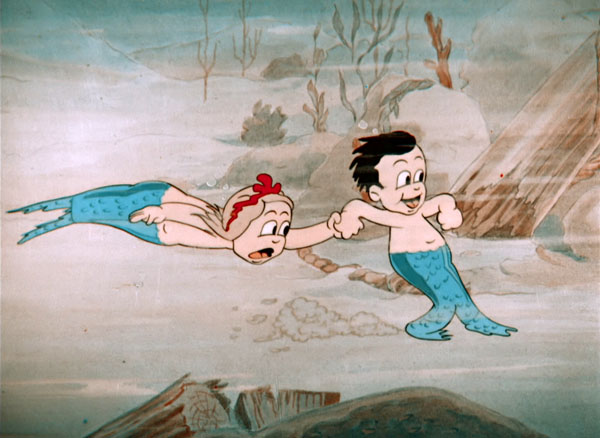
Of Rice and Hen (1953, McKimson)
McKimson revisits the courtship of Foghorn Leghorn and Miss Prissy, this time with writer Warren Foster, a calypso beat, and a bit of depth so often lacking in McKimson’s cartoons. Arguably the best of the ’50s Foggy cartoons. “There musta been some way I coulda lost.”

Pre-Hysterical Hare (1958, McKimson)
Like Dumb Patrol, it’s easy to imagine this stone age depiction of Bugs and Elmer as a classic made earlier in the decade. Instead, it’s about as lifeless as a Warner cartoon can get, aided by the John Seely stock music and Dave Barry voicing Elmer (Arthur Q. Bryan was not dead, he just wasn’t available). Inarguably the worst Bugs cartoon of the ‘50s.
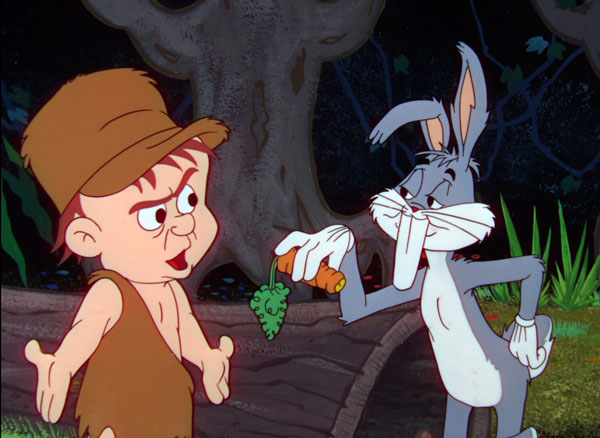
Punch Trunk (1953, Jones)
Oddball Jones-Maltese short about a miniature elephant driving the city out of its wits. Apes UPA with the human cast, psychodrama theme, and modern graphics.

Quentin Quail (1946, Jones)
Baby Snooks send-up with Ted Pierce voicing the beleaguered quail father in pursuit of a worm for his daughter’s breakfast.

Riff Raffy Daffy (1948, Davis)
Vagrant Daffy versus policeman Porky in a department store that has a detour into generic blackout gags between a very strong beginning and end that are as good as anything ever done with the characters.
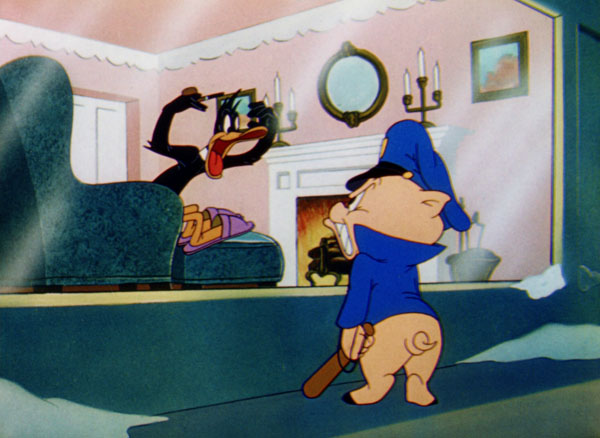
This cartoon, released in Cinecolor, has looked particularly horrible in every version I’ve ever seen (even the IB Technicolor rental prints look bad) and has been in long need of a reprieve. We got our answer why it’s always looked so bad during the production of this release: the original separation exposure negatives (Cinecolor only made the release prints and Warners was still timing these for Technicolor, as illustrated by the restorations of other Cinecolor releases) are actually missing (but still being searched for). There’s evidence that the materials went missing as far back as the mid-1960s. Extra care was taken to make a new version from the studio vault Super Cinecolor 35mm print look nicer than I’ve ever seen this cartoon, but it still unavoidably looks softer than the other cartoons sourced from the negs here.

Saddle Silly (1941, Jones)
Early Jones cartoon with a pony express carrier, a Native American named Moe Hican, and a pint-sized hitchhiker that tries to be funny but still hasn’t shed the Disney influence entirely.

Sheep Ahoy (1954, Jones)
Sam Sheepdog versus Ralph Wolf, with the notable Acme Artificial Rock (“Have Fun—Be Popular! BE A ROCK!”) device.
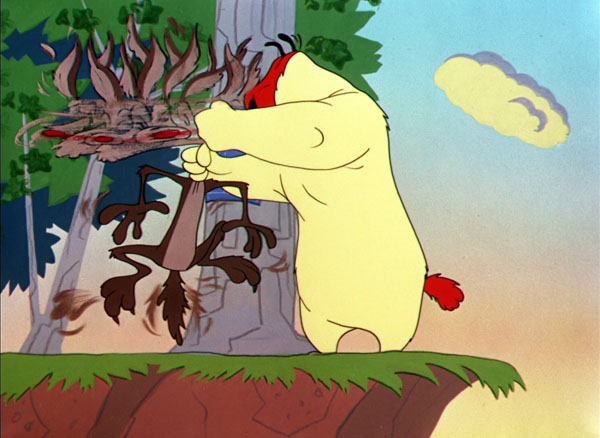
The Sheepish Wolf (1942, Freleng)
Another early, talky Maltese story for Freleng with a sheepdog and wolf, of the non-Sam and Ralph variety, competing for who’s stupider.

There Auto Be a Law (1953, McKimson)
McKimson and Pierce go back to the long abandoned spot-gag cartoon concept in the UPA-influenced era. The hot rod driver is a caricature of animator Ken Harris, who was a bit of an auto buff.

Tugboat Granny (1956, Freleng)
The Tweety formula on autopilot, but it has a cute opening song and some great Art Davis animation of Sylvester battling a crab.

War and Pieces (1964, Jones and Maurice Noble)
The last Jones Road Runner cartoon from the original run, mostly noteworthy for the “rule-breaking” of the Coyote ending up in China and chasing one of its native roadrunners.

Wet Hare (1962, McKimson)
Blacque Jacque Shellacque from Bonanza Bunny (1959) returns in a much funnier cartoon, this time hoarding Bugs’ water supply. Can you tell that a film with Bugs Bunny imitating Al Jolson in 1962 was made by tired men?

That’s all for now, folks… Bring on some more with Vol. 4!